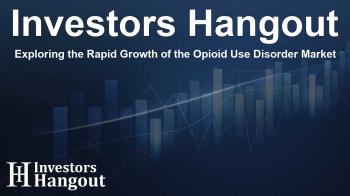Exploring the Rapid Growth of the Opioid Use Disorder Market

Understanding the Opioid Use Disorder Market and Its Promising Growth
The opioid crisis represents a major public health challenge, significantly impacting communities across the globe. According to research, the Opioid Use Disorder Market was evaluated at approximately USD 3.7 billion recently, with an exciting projection to surge to USD 9.02 billion by 2032. This extensive growth trajectory is underpinned by a compound annual growth rate (CAGR) of 10.4% from 2024 to 2032.
Main Drivers of Market Expansion
The ongoing rise in opioid addiction rates, combined with advancements in treatment options and supportive government initiatives, fuels the growing demand for effective solutions to tackle opioid use disorder (OUD). The World Health Organization has indicated that millions are suffering from opioid dependency, particularly in regions heavily affected by the crisis.
Government Initiatives and Funding
U.S. governmental bodies have made substantial financial commitments to address the opioid epidemic, with noteworthy investments aimed at enhancing medication-assisted treatment (MAT) programs. Reports suggest that in a recent allocation, billions were earmarked to expand access to these critical treatment options.
Innovations in Treatment Therapies
In addition to government efforts, the landscape of treatment options is evolving. The Food and Drug Administration (FDA) has been proactive, introducing several groundbreaking therapies that cater to OUD. Noteworthy among these are the long-acting injectable formulations of buprenorphine that have demonstrated higher patient compliance than traditional oral medications. Moreover, the adoption of telemedicine in prescribing and managing OUD treatments adds a modern twist to therapy accessibility.
Market Segmentation: Key Components
Understanding the various segments within the OUD market is crucial for stakeholders. Insights indicate that in 2023, buprenorphine led the charge, accounting for 58% of global revenue in this sector. The partial opioid agonist's widespread acceptance in MAT programs can be attributed to its efficiency in mitigating cravings and withdrawal symptoms.
Drug Class Analysis
The Buprenorphine segment, with novel formulations such as sublingual films and extended-release injections, showcases significant growth potential. While buprenorphine maintains a leading position, the Naltrexone segment is also poised for rapid growth thanks to its non-addictive profile, thereby being increasingly adopted in outpatient settings.
Administration Routes and Distribution Channels
In terms of delivery, injectable forms represented 60% of revenues, attributed to their efficacy in providing long-lasting therapeutic effects. Hospital pharmacies have remained at the forefront of distribution, showcasing their critical role in dispensing OUD medications, particularly for those receiving inpatient care.
Regional Insights and Global Trends
Geographically, North America accounts for a substantial 66% of the global market share. This dominance reflects both the high prevalence of opioid addiction and robust healthcare supportive frameworks. The region has seen comprehensive governmental backing designed to combat the opioid crisis. As for Europe, governments are increasingly endorsing innovative treatments and harm reduction strategies.
Asia-Pacific Growth Opportunities
The Asia-Pacific region is expected to experience rapid market growth, driven by increased opioid consumption and developing healthcare infrastructures. Countries are investing heavily in addiction treatment programs and public education efforts, aiming to create a positive impact on the current crisis.
Recent Developments Shaping the Future
Recent measures taken by major players in the market, including new product launches and significant investments in treatment programs, provide a glimpse into the evolving landscape of OUD treatment. For instance, executive measures from companies like Indivior and Camurus have led to the introduction of enhanced treatment options, thereby promoting better adherence and convenience for patients.
Frequently Asked Questions
What is the current market size of the opioid use disorder market?
As of now, the market is valued at approximately USD 3.7 billion.
What is the projected growth of the opioid use disorder market?
The market is projected to reach USD 9.02 billion by 2032, growing at a CAGR of 10.4%.
What are the main drivers behind market growth?
The increase in opioid addiction rates, advancements in treatment, and government support initiatives are primary growth drivers.
Which drug class leads the opioid use disorder market?
Buprenorphine currently dominates the market segment, accounting for 58% of global revenue.
What regions are expected to see the fastest growth in the market?
The Asia-Pacific region is anticipated to experience rapid growth due to rising opioid consumption and improving healthcare infrastructure.
About The Author
Contact Hannah Lewis privately here. Or send an email with ATTN: Hannah Lewis as the subject to contact@investorshangout.com.
About Investors Hangout
Investors Hangout is a leading online stock forum for financial discussion and learning, offering a wide range of free tools and resources. It draws in traders of all levels, who exchange market knowledge, investigate trading tactics, and keep an eye on industry developments in real time. Featuring financial articles, stock message boards, quotes, charts, company profiles, and live news updates. Through cooperative learning and a wealth of informational resources, it helps users from novices creating their first portfolios to experts honing their techniques. Join Investors Hangout today: https://investorshangout.com/
The content of this article is based on factual, publicly available information and does not represent legal, financial, or investment advice. Investors Hangout does not offer financial advice, and the author is not a licensed financial advisor. Consult a qualified advisor before making any financial or investment decisions based on this article. This article should not be considered advice to purchase, sell, or hold any securities or other investments. If any of the material provided here is inaccurate, please contact us for corrections.

